
Upside-Down “Rivers” Threaten Antarctic Ice Shelves
Scripps researchers use satellite laser altimetry to provide first look at basal channels around Antarctica
Published Date
By:
- Brittany Hook
Share This:
Article Content

The front of the Ross Ice Shelf floats in the Ross Sea, as seen from the cockpit of an LC130 aircraft flown by the New York Air National Guard. Photo by Matt Siegfried
“Upside-down rivers” of warm ocean water threaten the stability of floating ice shelves in Antarctica, according to a new study led by researchers at the University of Colorado Boulder’s National Snow and Ice Data Center (NSIDC) and co-authored by researchers at Scripps Institution of Oceanography at UC San Diego. Published today in the journal Nature Geoscience, the study highlights how parts of Antarctica’s ice sheet may be weakening due to contact with warm ocean water.
As ice shelves flow out to sea, they push against islands, peninsulas, and bedrock bumps known as “pinning points.” Contact with these features slows the flow of grounded ice off the continent. While ice shelves take thousands of years to grow, previous work has shown that they can disintegrate in a matter of weeks. If more ice shelves disintegrate in the future, loss of contact with pinning points will allow ice to flow more rapidly into the ocean, increasing the rate of sea-level rise.

A large rift at the front of the Ross Ice Shelf near McMurdo Station in Antarctica. Photo by Matt Siegfried
“We found that warm ocean water is carving these upside-down rivers, or basal channels, into the undersides of ice shelves all around the Antarctic continent. In at least some cases these channels weaken the ice shelves, making them more vulnerable to disintegration,” said Karen Alley, a PhD student in CU-Boulder’s Department of Geological Sciences, and lead author of the study.
The features form as buoyant plumes of warm and fresh water rise and flow along the underside of an ice shelf, carving channels much like upside-down rivers. The channels can be tens of miles long, and up to 800-feet “deep.”
“This paper is the first inventory of these basal channels all around Antarctica,” said Matthew Siegfried, a postdoctoral scholar at Scripps Oceanography, and co-author of the study. “We show that these channels are extremely dynamic features that can change rapidly. Our observations demonstrate that they can deepen, they can lengthen, and, perhaps most importantly, they can cause the larger regions of the ice shelf to crack.”
When a channel is carved into the base of an ice shelf, the surface of the ice shelf sags, leaving a visible depression in the relatively smooth ice surface. Alley and her colleagues mapped the locations of these depressions all around the Antarctic continent using satellite imagery, as well as radar data that images the channels through the ice, mapping the shape of the ice-ocean boundary.
Researchers at Scripps were able to document how quickly some of the channels were growing through the use of satellite laser altimetry, which measures the height of an ice shelf surface with high accuracy. The data show that growing channels on the rapidly melting Getz Ice Shelf in West Antarctica can bore into the ice shelf base at rates of approximately 10 meters (33 feet) each year.
The mapping shows that basal channels have a tendency to form along the edges of islands and peninsulas, which are already weak areas on ice shelves. The team observed two locations where ice shelves are fracturing along basal channels, clear evidence that basal channel presence can weaken ice shelves to the point of breaking in vulnerable areas.
While no ice shelves have ever completely disintegrated due to carving by basal channels, the study points to the need for more observation and study of these features, said Scripps Oceanography glaciologist Helen Amanda Fricker, a co-author of the study.
“It's feasible that as ocean temperatures around Antarctica rise, melting in basal channels could contribute to increased erosion of ice shelves from below.”
The study, “Impacts of warm water on Antarctic ice shelf stability through basal channel formation,” was led by University of Colorado Boulder PhD student Karen Alley, who worked with Siegfried and Fricker as well as co-author Ted Scambos of NSIDC. Their work was funded in part by NASA and the U.S. Geological Survey.
- This is a joint release of the National Snow and Ice Data Center (part of the Cooperative Institute for Research in Environmental Sciences at the University of Colorado Boulder) and Scripps Institution of Oceanography at UC San Diego.
Share This:
You May Also Like
Stay in the Know
Keep up with all the latest from UC San Diego. Subscribe to the newsletter today.


